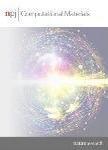Intersystem crossing and exciton–defect coupling of spin defects in hexagonal boron nitride
作者机构:Department of PhysicsUniversity of CaliforniaSanta CruzCAUSA Lawrence Livermore National LaboratoryLivermoreCAUSA Department of Chemistry and BiochemistryUniversity of CaliforniaSanta CruzCAUSA
出 版 物:《npj Computational Materials》 (计算材料学(英文))
年 卷 期:2021年第7卷第1期
页 面:537-544页
核心收录:
学科分类:081702[工学-化学工艺] 08[工学] 0817[工学-化学工程与技术]
基 金:We acknowledge Susumu Takahashi for helpful discussions.This work is supported by the National Science Foundation under grant nos.DMR-1760260,DMR-1956015 and DMR-1747426 Part of this work was performed under the auspices of the U.S.Department of Energy by Lawrence Livermore National Laboratory under Contract DE-AC52-07NA27344 T.J.S.acknowledges the LLNL Graduate Research Scholar Program and funding support from LLNL LDRD 20-SI-004 This research used resources of the Scientific Data and Computing center,a component of the Computational Science Initiative,at Brookhaven National Laboratory under Contract No.DE-SC0012704 the lux supercomputer at UC Santa Cruz,funded by NSF MRI grant AST 1828315 the National Energy Research Scientific Computing Center(NERSC)a U.S.Department of Energy Office of Science User Facility operated under Contract No.DE-AC02-05CH11231 the Extreme Science and Engineering Discovery Environment(XSEDE)which is supported by National Science Foundation Grant No.ACI-154856262
摘 要:Despite the recognition of two-dimensional(2D)systems as emerging and scalable host materials of single-photon emitters or spin qubits,the uncontrolled,and undetermined chemical nature of these quantum defects has been a roadblock to further *** the design of extrinsic defects can circumvent these persistent issues and provide an ultimate ***,we established a complete theoretical framework to accurately and systematically design quantum defects in wide-bandgap 2D *** this approach,essential static and dynamical properties are equally considered for spin qubit *** particular,many-body interactions such as defect–exciton couplings are vital for describing excited state properties of defects in ultrathin 2D ***,nonradiative processes such as phonon-assisted decay and intersystem crossing rates require careful evaluation,which competes together with radiative *** a thorough screening of defects based on firstprinciples calculations,we identify promising single-photon emitters such as SiVV and spin qubits such as TiVV and MoVV in hexagonal boron *** work provided a complete first-principles theoretical framework for defect design in 2D materials.



